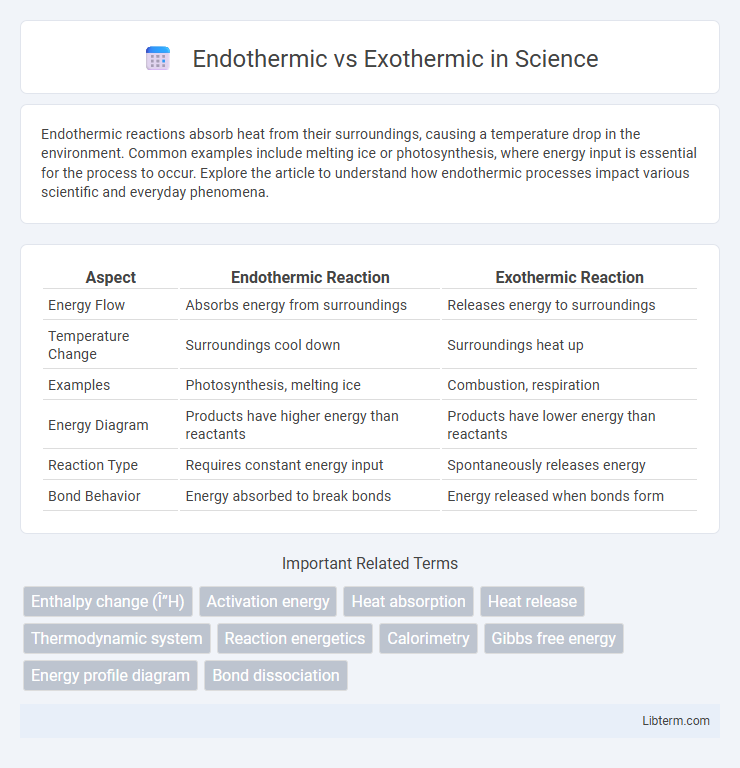Endothermic reactions absorb heat from their surroundings, causing a temperature drop in the environment. Common examples include melting ice or photosynthesis, where energy input is essential for the process to occur. Explore the article to understand how endothermic processes impact various scientific and everyday phenomena.
Table of Comparison
| Aspect | Endothermic Reaction | Exothermic Reaction |
|---|---|---|
| Energy Flow | Absorbs energy from surroundings | Releases energy to surroundings |
| Temperature Change | Surroundings cool down | Surroundings heat up |
| Examples | Photosynthesis, melting ice | Combustion, respiration |
| Energy Diagram | Products have higher energy than reactants | Products have lower energy than reactants |
| Reaction Type | Requires constant energy input | Spontaneously releases energy |
| Bond Behavior | Energy absorbed to break bonds | Energy released when bonds form |
Introduction to Endothermic and Exothermic Reactions
Endothermic reactions absorb energy from their surroundings, often resulting in a temperature decrease as heat is taken in to break chemical bonds. Exothermic reactions release energy, usually in the form of heat or light, due to the formation of new chemical bonds that release excess energy. Understanding the energy flow in these reactions is crucial for applications in chemistry, biology, and industrial processes.
Defining Endothermic Reactions
Endothermic reactions absorb energy from their surroundings, typically in the form of heat, causing a temperature decrease around the reaction site. These reactions require an input of energy to break chemical bonds, resulting in products with higher energy than the reactants. Examples of endothermic processes include photosynthesis and the melting of ice.
Defining Exothermic Reactions
Exothermic reactions release energy, usually in the form of heat, to the surroundings during the chemical process. This energy release results from the formation of stronger bonds in the products compared to the reactants, causing the overall system to lose heat. Common examples include combustion, respiration, and condensation, where exothermic reactions drive natural and industrial processes by increasing ambient temperature.
Key Differences Between Endothermic and Exothermic Processes
Endothermic processes absorb energy from the surroundings, resulting in a temperature decrease, whereas exothermic processes release energy, causing the surroundings to warm up. In chemical reactions, endothermic reactions require an input of heat to proceed, while exothermic reactions generate heat as they progress. These distinctions are crucial for understanding energy flow in physical and chemical changes, influencing reaction spontaneity and equilibrium.
Energy Changes and Heat Flow
Endothermic reactions absorb energy from their surroundings, resulting in a decrease in temperature as heat flows into the system. Exothermic reactions release energy, causing an increase in temperature as heat flows out of the system. The difference in heat flow dictates the thermodynamic nature of these reactions, with endothermic processes requiring energy input and exothermic processes producing energy output.
Real-Life Examples of Endothermic Reactions
Endothermic reactions absorb heat from their surroundings, making processes like photosynthesis in plants and the melting of ice prime real-life examples. These reactions require energy input to break chemical bonds, as seen in cooking an egg or evaporating water. Understanding these processes highlights the role of endothermic reactions in everyday energy transfer and chemical transformations.
Real-Life Examples of Exothermic Reactions
Combustion of fuels, such as burning gasoline in engines, represents a common exothermic reaction that releases heat and enables vehicle motion. Another real-life example includes the process of respiration in living organisms, where glucose oxidation produces energy and heat. The formation of ice from water during freezing also exemplifies an exothermic reaction as heat is released to the surroundings.
Applications in Industry and Daily Life
Endothermic reactions absorb heat, making them essential in industrial processes like photosynthesis-based biofuel production and refrigeration systems, where cooling effects are required. Exothermic reactions release heat, widely applied in combustion engines, metal forging, and self-heating food packaging. Understanding these thermal dynamics optimizes energy efficiency and safety in manufacturing, environmental control, and consumer products.
Importance in Chemical and Biological Systems
Endothermic and exothermic reactions play crucial roles in chemical and biological systems by regulating energy flow and maintaining system stability. Endothermic processes absorb energy, enabling key biological functions such as photosynthesis and cellular respiration, while exothermic reactions release energy essential for metabolism and heat generation. Understanding these thermal dynamics is vital for advancements in fields like biochemistry, pharmaceuticals, and environmental science.
Summary: Comparing Endothermic and Exothermic Reactions
Endothermic reactions absorb energy from their surroundings, resulting in a temperature decrease, while exothermic reactions release energy, causing a temperature increase. These reactions differ in energy flow: endothermic processes require energy input to break bonds, whereas exothermic processes release energy through bond formation. Understanding these energy changes is crucial for applications in chemistry, biology, and industrial processes.
Endothermic Infographic

 libterm.com
libterm.com